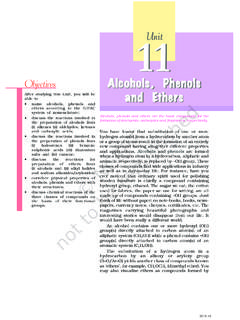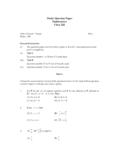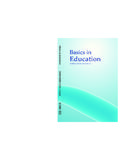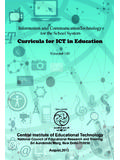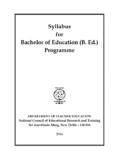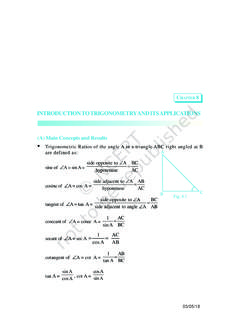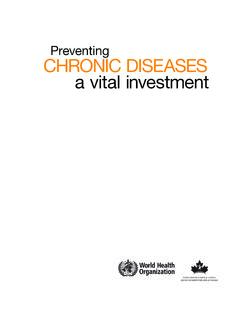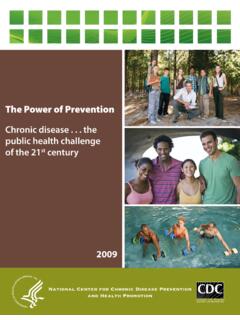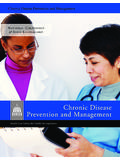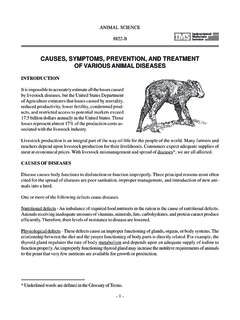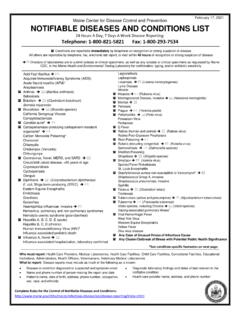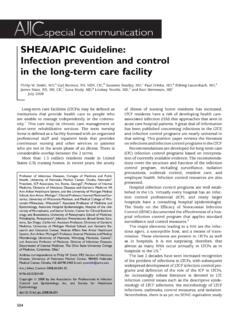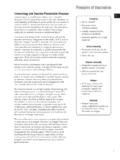Transcription of Health and Diseases 1
1 Health and IntroductIonWe normally relate the terms Diseases and illness interchangeably in relation to Health , even though these words do not mean the same. Health is the general condition of a person in respect to all aspects of life. It is also a level of functional and/or metabolic efficiency of an organism. The word metabolic is the adjective of the term metabolism which means the whole range of big chemical processes that occur within us or any living organism to produce energy and basic materials needed for important life processes. Diseases and illness adversely affect these processes. And thus Health , Diseases and illness are inter-related. However, Health is not just being free from Diseases , illness or injury. As defined by World Health Organisation (WHO), Health is a state of complete physical, mental and social well-being and not merely an absence of disease or infirmity.
2 What Is Illness?Let s now see how is illness different from that of disease ? While illness and disease are at times used interchangeably, these in fact, are different from each other. disease refers to a biomedically defined deviation from norms of body function or structure, whereas, illness is the experience of this deviation. It is a state of experience by the body when one or more of the control systems of the body are not functioning normally. Illness refers to a subjective distress feeling of a person, when one is sick or suffering from some disease . However, it is not appropriate to conclude that any one being merely free from illness or disease is might have seen people suffering from various types of Diseases . Some of the Diseases , like high blood pressure affect only a particular person who is suffering from it.
3 On the other hand, some Diseases like common cold, spread rapidly and affect a number of people in a very short period. You must have often wondered as to how does this happen. In one of the chapters of your textbook on Science, you would have studied about Why We Fall Ill . In that chapter, it is mentioned how Diseases are caused and how some of these affect only the persons who suffer from them are called non- communicable , whereas, there are those Diseases that are transmitted from one 2021 222 Health and Physical Education Class IXperson to another are known as communicable . The chapter also mentions how communicable and non- communicable Diseases can be prevented and controlled. communicable Diseases Let us understand how communicable Diseases are spread. These Diseases are caused by certain infectious agents which may be bacteria or viruses.
4 These are capable of being transmitted from person to person or from the environment to Classification communicable Diseases can be classified on the basis of the causative organisms. These are as follow: Bacterial: Typhoid, Cholera, Tuberculosis Viral: Common cold, Influenza, HIV infection, Dengue Protozoal: Malaria, Kala azar Fungal: Fungal infections of nails, groins, skin, hair Parasitic: Infestations of intestinal worms, like round worm, or of transmission: The modes of transmission can be classified as direct and indirect transmission. (a) Direct transmissionAs we have studied in our earlier classes, direct transmission of Diseases takes place as follows:Direct contact or touching: When we touch a person or come in direct contact with the skin or mucous membrane of the diseased person, it transmits infections like skin and eye infection: Spray of droplets of saliva or secretion of a diseased person spreads common cold, tuberculosis, with soil: Can cause acquiring the disease agent directly and may spread Diseases like: hookworm infestation and into skin or mucosa: Certain Diseases spread in other ways.
5 For example, Rabies is spread to humans from animal. It is generally known that it occurs due to a dog or a monkey bite. Hepatitis occurs owing to virus, transmitted through contaminated needles. The HIV (Human Immunodeficiency Virus) can be transmitted by sexual contact or through transmission of infected blood from an infected person. HIV can be transmitted by the HIV infected mother to baby and can cause AIDS (Acquired Immune Deficiency Syndrome).actIvIty with your classmates, why we should not go to public places when suffering from cold, cough or fever?Chapter-1 Health & 208-11-2016 11:04:47 AM2021 22 Health and Diseases 3(b) Indirect transmissionCommunicable Diseases are also transmitted indirectly in the following ways that are popularly known as 5Fs flies, fingers, fomites (material capable of carrying infections, like towels, handkarchiefs etc.)
6 , food and fluid. Some Diseases are spread through water, food, ice, blood and body tissues and organs. For example, typhoid, diarrhoea, polio, intestinal parasites and infective hepatitis. Flies contaminate food and other living carrier (also known as a vector) is a disease agent that lives on or inside the body of the carrier causing Diseases like malaria and plague. Airborne infectious materials transmitted through droplet infection or dust cause Diseases like respiratory infections and itch mites. Fomites are objects like towels, handkerchiefs, toys, glass, spoons, etc. which we use daily. Eye and skin infections and dysentery (diarrhoea with blood) are spread through these fomites. Our unclean hands and fingers act as disease causing agents and transfer infection to food through skin, nose, and causes Diseases , such as intestinal parasites, dysentery, typhoid.
7 Healthy people can also spread disease if they are carriers . These are the people who themselves may be immune to the organisms they harbour, but can be a source of transmission to others as happens in the case of typhoid. prevention and control of communicable DiseasesThe following measures help in prevention and control the spread of communicable Diseases :Personal hygiene Bathing everyday and clean clothes keep our body free from harmful microbes. Cutting nails and washing hair regularly. Brushing teeth twice a day (morning and night) particularly after meals. Ensuring that your ears are clean. Do not share articles that are of personal use, that is, towels, soaps, tooth brushes, combs, razors and other toiletries. Wash hands before touching food or water and before eating or drinking. Wash hands with soap and water before touching your face, eyes and mouth and also before and after using the toilet.
8 Many microbes like virus, bacteria and fungi are transmitted by touching surfaces with hands and actIvIty List how many things you follow for food and water hygiene Discuss the list with your friend. What would you like to do to improve your personal Health & 308-11-2016 11:04:47 AM2021 224 Health and Physical Education Class IXbecome potential carriers. Hence by washing hands, we can prevent Diseases like diarrhoea, flu, skin and eye and water hygiene Drink potable water. If it does not appear clean, boil or filter and then consume it. Eat only freshly prepared food or consume it within four hours of preparation. Do not purchase and consume fruits and vegetables which have been cut and kept in the open for a long time. Keep all food articles covered to prevent contamination by sanitation Use sanitary latrines; avoid open air defecation.
9 Throw waste in dustbins to avoid breeding of flies. Clean the drains regularly. Regularly check the places where water is collected and has the possibilities of mosquito breeding. Spray insecticide to prevent breeding of mosquitoes. Try to prevent contamination of drinking water (source of water should be away from source of garbage collection/waste disposal site). The container of drinking water must be kept at a clean and safe Vaccines boost immunity and thus helps the body fight Diseases . A large number of infectious Diseases can be prevented by taking vaccines at an appropriate time, such as, diphtheria, pertussis, polio, tetanus, rabies, measles, chickenpox, typhoid, of Diseases using medicines Medicines kill microbes and /or slow their growth. These are classified as anti-virals, anti-fungals, anti-protozoals and antibiotics according to the group of microbes they act upon.
10 However, these medicines should be taken in the recommended dose and duration as advised by the doctor. One should avoid of patients with communicable diseasesPatients suffering from such Diseases that are communicable should be kept in a clean environment isolated from and awarenessIt is important to make people aware about communicable Diseases , their causes and modes of spread. People should actIvIty a round of your school. Find out the environmetnal with your classmates. If it is not good what will you do? Prepare a plan and an Immunisation chart. Put it in your classroom. Discuss with your classmates whether everyone has been vaccinated? If not, request them to consult a nearby Health Health & 408-11-2016 11:04:47 AM2021 22 Health and Diseases 5also be made aware of their responsibilities towards control of communicable Diseases , ensuring use of safe water, healthy food and proper management of garbage and waste disposal.
